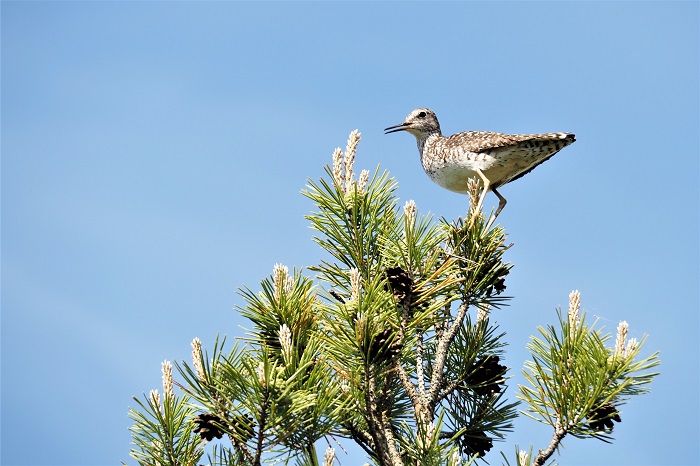Nature
The nature of the protected area is primarily characterised by the bog, which is surrounded by various types of forest and is the heart of the area’s hydrological cycle. The protected raised bog consists of the Mukri bog in the north and the Ellamaa bog in the south. The bogs are named after nearby villages of the same name. The two bogs are often jointly called the Mukri bog.
Raised bog
The raised bog is named after its thick layer of peat. This is why bogs are always higher than the area surrounding them. The raised bog is the last development stage of bogs, where the layer of peat is so thick that the roots of plants cannot reach the nutrient-rich mineral soil or groundwater. Peat is partially decayed vegetation, an organic sediment that forms in an environment that is high in water, low in oxygen and acidic. Peat is low in nutrients, which is why the special vegetation of bogs primarily receives its nutrients from the dust in precipitation. The peat layer of the Mukri bog is on average 4.6 m thick and the deepest layers reach 8.5 m.
The bog is the largest habitat type of the Mukri Nature Reserve, accounting for a little more than half of the protected area, i.e. 51%. Transition mires occur in the southern part of the Ellamaa and the Mukri bog, some of which are natural and some having formed in former peat extraction sites. The central part of the bog is a wooded bog and on its outskirts is transition and fen woodland.
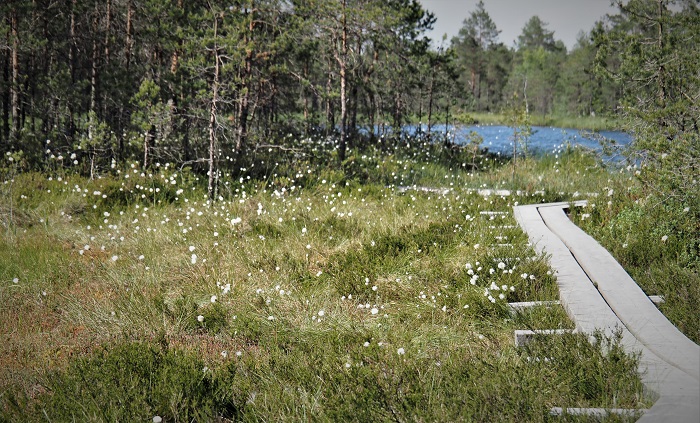
The Mukri bog has remained untouched by major human activity and has therefore largely maintained its natural way of life. Although peat has been extracted from here as well, it was done by hand and in a small area, which limited the extent of damage. Peat was extracted here for animal bedding and heating between 1920 and 1950 by the Kobra peat cooperative, individual producers and the local collective. Peat extraction is evidenced by ditches in the part towards Eidapere and little peat pits and peat stacks can be seen beside the boardwalk leading from the gravel road directly to the lake. In the western part of the bog, preparations have been made for peat extraction. In the southern part are 55 hectares of old quarries where peat was dug with spades. In the last century, before the protected area was formed, drainage ditches were dug in the area, which have had a negative impact on the environmental values of the area. As a result, some of the bog pools have closed up. There is a plan to close the ditches in the future in order to restore the original hydrological regime and habitats in the areas affected by human activity.
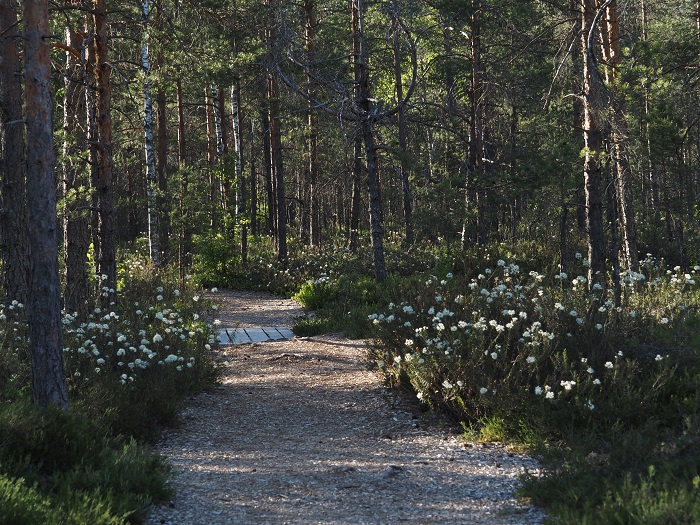
Water
Peat absorbs and retains a great deal of water. In natural bogs, peat is on average 90% water. Therefore, most of the protected area’s water is in the peat, which accumulates water from precipitation. The water draining out of the higher central part of the Mukri bog flows into the Imsi Stream and Vaki Stream and the Massu River. These running waters flow into the Vändra River, which carries the water through the Pärnu River into the Gulf of Riga in the Baltic Sea. The hydrological cycle of the bog has a major impact in preventing floods in the surrounding areas as well as alleviating droughts.
The Mukri bog has numerous bog hollows and bog pools. A bog pool is a little body of free water in peat soil. Bog pools are characteristic to older bogs. Bog hollows are lower and more watery spots on the surface of the bog, which are still covered in vegetation.
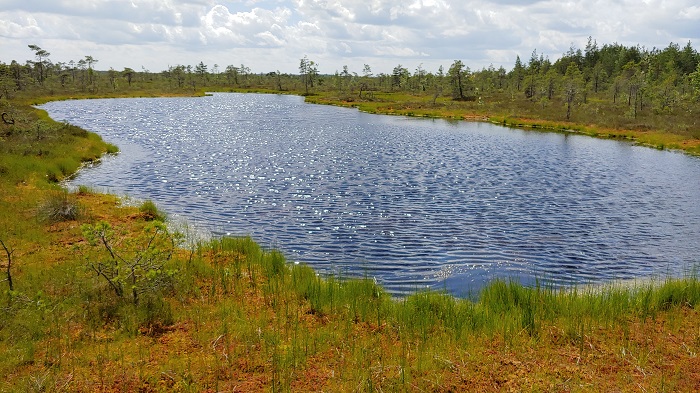
The northern part of the Ellamaa bog has several lakes, the largest being the 2.2-ha Lake Eidapere. A swaying sward has formed on the shore of the lake. The lake is 340 m long, 100 m wide and the well-structured shoreline is 1605 m. Similarly to typical bog lakes and bog pools, the water of Lake Eidapere is brownish due to peat and humic substances. Humic substances are water-insoluble collections of organic matter in peat. Such bodies of water are the habitat of rare plankters found in northern regions. A plankter is a tiny organism that floats in water. Lake Eidapere has three peat islets, which are not connected to mineral soil. The lake is abundant in white waterlilies and dwarf white waterlilies. Both protected species are a wonderful sight when in bloom (from June to July).
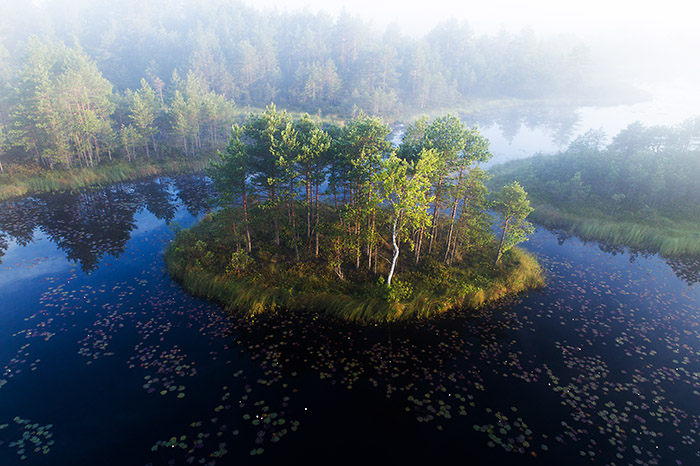
Forests
The most common forest communities in the Mukri Nature Reserve are transition mire and bog forests, totalling 234 ha, which make up 11% of the protected area. These forests are a suitable habitat for the western capercaillie. In the northern part of the protected area and on the outskirts are old-growth forests, which account for 3% of the protected area. Old-growth forests are old forests with little human impact where favourable habitats have developed over time for many currently endangered species. There are endangered species among the mosses, lichens, fungi and animals.
Old-growth forests also include grassy spruce forests, which account for just 1 ha of the Mukri Nature Reserve. Such forests grow in areas with a good water supply, where groundwater flows close to the surface and the soil is nutrient-rich. These are forest stands with rich soil, consisting mostly of spruces.
To the south of the Mukri bog is an 11-ha community of paludifying forests and deciduous bog forests. This forest habitat is also characterised by the closeness of groundwater to the ground, which can often reach the surface during spring high water. In such conditions, so-called stem sods form around the lower part of tree stems.
The protected area has also severely drained peatland forests with a considerable amount of thick down timber, stubs and other elements that increase the diversity of forest habitats. Often, these elements are important, especially as habitats of rare species, such as mosses and lichens.
Meadows – semi-natural grasslands
Meadows, or semi-natural grasslands, have become rare, which endangers the habitats and feeding areas of the species associated with these biotic communities. In the eastern part of the Mukri Nature Reserve, there are nearly five hectares of meadow with meadow foxtail and great burnet. The grassland has probably been used as a field and been moderately fertilised, which has reduced its species composition. In order to preserve the biotic community, it is necessary to continue human activity, i.e. mowing.
Protected species
The Mukri Nature Reserve is home to many species, including protected ones. Conservation objectives have been established in Mukri for four protected plant species. These are the ghost orchid of protected category I and the poor sedge, the early coralroot and the lesser twayblade of protected category II.
Other protected plant species in the area include the bog orchid and the slender cottongrass of protected category II and the creeping lady’s-tresses, the northern firmoss, the dwarf white waterlily, the white waterlily, the heath spotted-orchid and the common spotted-orchid of protected category III.
Three bird species – the black stork, the western capercaillie and the northern goshawk – are under special observation in the Mukri Nature Reserve.

The black stork is a migratory bird, a stork belonging to protected category I. The status of the species in Estonia is critical. Its numbers have decreased from 250 breeding pairs in the early 1980s to the current 40–60 pairs. This is due to the loss of suitable feeding areas and habitats as a result of human activity. The black stork only lives in old natural forests near shady watercourses. In addition to the black stork, such old forests are the habitat of up to 400 other endangered species. The black stork is an umbrella species of other endangered species because protecting the black stork protects all other species in the area.
The best-known black stork in Mukri is a young father named Oss and his son Ossipoeg from 2008. In the summer of 2008, they were given names and fitted with radio transmitters. The transmitter recorded the 2008 migration of both birds and the movements of Oss up until 2011. These movements along with additional information and pictures (open by clicking on the name of the bird) are available here.
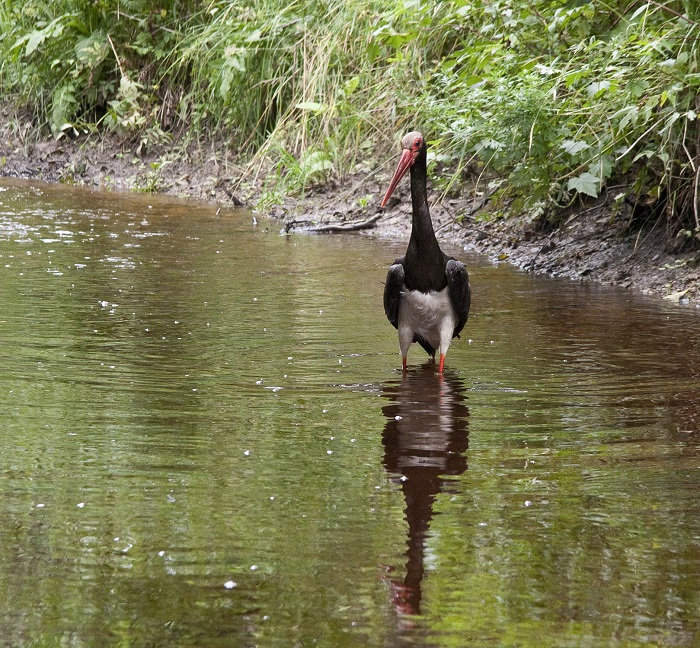
The western capercaillie is a resident bird, a grouse with decreasing numbers belonging to protected category II. The western capercaillie is known for the courtship displays that male birds put on in the spring. The Mukri Nature Reserve is an important habitat of the western capercaillie, because it serves as a corridor connecting nearby western capercaillie areas. On the outskirts of the bog are two areas where courtship displays have occurred with six males.
The northern goshawk belongs to protected category II and is a resident bird with scattered distribution in Estonia. Its numbers have significantly decreased due to intensive forest management. The northern goshawk has been nesting in Mukri for a long time and efforts are being made to maintain the situation. The area is favourable for the species because Mukri is an important area of the western capercaillie, which is one of the prey species of the northern goshawk. Read more about the species in the magazine Eesti Loodus.
Other protected species in the Mukri Nature Reserve include the Eurasian three-toed woodpecker of protected category II and the black grouse, the great grey shrike, the red-backed shrike, the mistle thrush, the parrot crossbill, the common redshank, the wood sandpiper, the common greenshank, the common crane, the common buzzard and the Eurasian sparrowhawk of protected category III.
